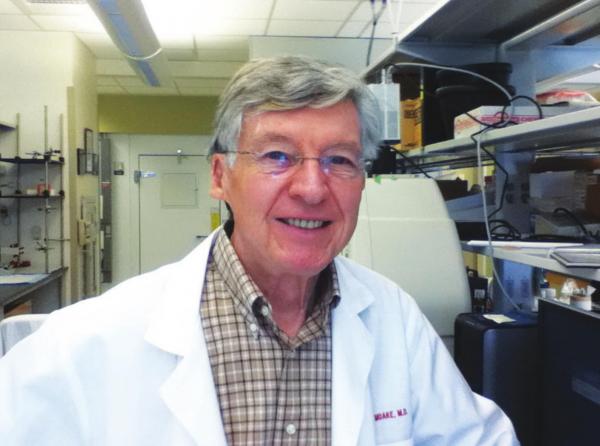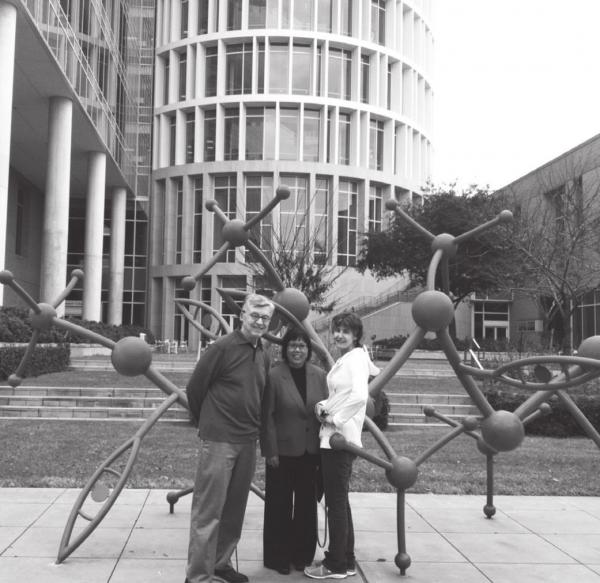Life saving research, then relax by the Blanco
One of the things that makes Wimberley special is the many interesting and talented people who live here.
You could be standing in the produce section at Brookshire Brothers searching for that perfect avocado and the man standing next to you could be an accomplished research scientist whose discovery led to the successful treatment for a once-fatal blood disease.
Dr. Joel Moake and his wife Betty split their time between Wimberley — where his house overlooks the Blanco River — and Houston — where he oversees operations of the Moake Laboratory in Hemostasis-Thrombosis Research at Rice University.
Simply, Dr. Moake and his team study how blood clots. For some, blood clots too much. For others, not enough. Either way it’s a problem.
The Centers for Disease Control estimates that 900,000 Americans suffer from some sort of clotting disorder annually and as many as 100,000 die each year from blood clots.
In the 1980s, Dr. Moake and his colleagues discovered the origin of a rare blood disorder that led to excessive clotting and eventually heart attacks, strokes and kidney failure in the people who suffered from the disease. Once he overcame the skepticism of fellow researchers — which took more than a decade — his discovery led to an effective treatment for thrombotic thrombocytopenic purpura or, as it’s widely known, TTP.
“So now most people don’t die (from TTP) with the form of therapy that has evolved,” says Dr. Moake. “That is extremely gratifying to me.”
Medical career
You might say Dr. Moake stumbled into medicine.
He was born in the small Texas town of Gorman, between Fort Worth and Abilene. His grandmother ran the general store/funeral parlor/lumber yard and helped start the hospital. He was born in that hospital on Christmas Eve in 1940. “You could say she was a feminist before there was feminism,” says Dr. Moake.
The family moved to San Antonio when he was three. His father ran the Bain Peanut Company and sold nuts to local candy producers.
As a youngster, Joel loved art and his poster-sized drawing of television cowboy Hopalong Cassidy won a trip for the family to Walt Disney Studios in Burbank, Calif. He was guided through the studios by Roy Disney, Walt’s brother. “He (Roy) was such a nice man, just wonderful,” Dr. Moake recalls.
Joel was a top student at Highland High School in San Antonio and decided to attend Texas Christian University, to study chemistry and biology and play baseball.
He met Betty at TCU and was a “good hitter and a decent fielder” for the Horned Frogs. But a severe ankle fracture put an end to his baseball dreams. Two orthopedic surgeons — brothers who graduated from Johns Hopkins University — treated Joel and, at the same time, recruited him for the famed medical school in Baltimore.
Just plain Joe
Dr. Moake’s birth certificate lists his name Joe Lawrence Moake. Around Gorman and San Antonio he was known as “Joe L.”
“In Central Texas people often went by double names,” he says. The folks at Johns Hopkins had a hard time understanding how someone could just be named Joe. “Is it Joseph?” they asked. “No, just Joe,” he replied. Still not satisfied, everyone eventually settled on Joel. Today, Dr. Moake answers to Joel, Joe and probably Joe L.
He married Betty, left TCU after his junior year and earned his bachelor’s degree from Johns Hopkins. Then it was medical school and a series of jobs that stretched from Miami to Boston.
“During medical school I became enamored with hematology,” Dr. Moake recalls. “I was interested in the molecular forms of medicine.”
At Johns Hopkins he was a year ahead of the son of Jonas Salk, the legendary conqueror of polio.
“I worked on bleeding and clotting problems in medical school and never lost interest in that,” explains Dr. Moake.
He followed a professor to University of Florida where he served his internship. He then took a position at the National Cancer Institute back in Baltimore. He was drafted into the Navy and became a junior officer, but continued his blood research.
“We didn’t pay too much attention to it (the Navy),” he says with a slight smile, “because no one wore uniforms and no one saluted.” But for a struggling intern, Navy pay — $11,000- $12,000 a year — was most welcome.
Then it was back to Florida for a fellowship in hematology, the study of blood, and research into leukemia, lymphoma and hemophilia. Meanwhile, Betty worked as a speech therapist.
The next stop was at the veteran’s hospital near Boston where he oversaw a large, state-of-the-art lab.
Back to Texas
It was time to return to Texas in the mid-1980s. Dr. Moake accepted a position at the Baylor College of Medicine in Houston. Personal medical issues made it difficult to cover the six hospitals that the Baylor system operated so it was on to Rice and Moake Lab. Dr. Moake is still a professor emeritus at Baylor.
There are six researchers at the lab in Houston — four physicians and two clinicians. Graduate students also assist.
The funding has come from both public sources and private foundations. Mary Rodes Gibson was a successful real estate investor who suffered from a blood disorder. She was Dr. Moake’s patient for years and when she passed away in her 90s she left her estate to a foundation which today provides a good share of the funding for the Moake Laboratory.
Dr. Moake’s crowning achievement was his research into the origins of TTP. “No one believed it at first,” Dr. Moake says. “They said, ‘this guy is goofy.’ There was a tremendous amount of resistance. It took 15-20 years before it became clear that this was the answer.”
Eventually, his findings were published in the prestigious New England Journal of Medicine, a treatment was developed and thousands of lives have been saved.
For many people 2020 has been a less-than-stellar year and that holds true for the lab. “We had a terrible year where we can’t be together as much. We mostly interact through Zoom and telephone,” Dr. Moake says.
Dr. Moake and Betty have had a home in Woodcreek or Wimberley for 25 years.
These days some of the world-class research is being coordinated from the living room of his Wimberley home with a sweeping view of the Blanco.



